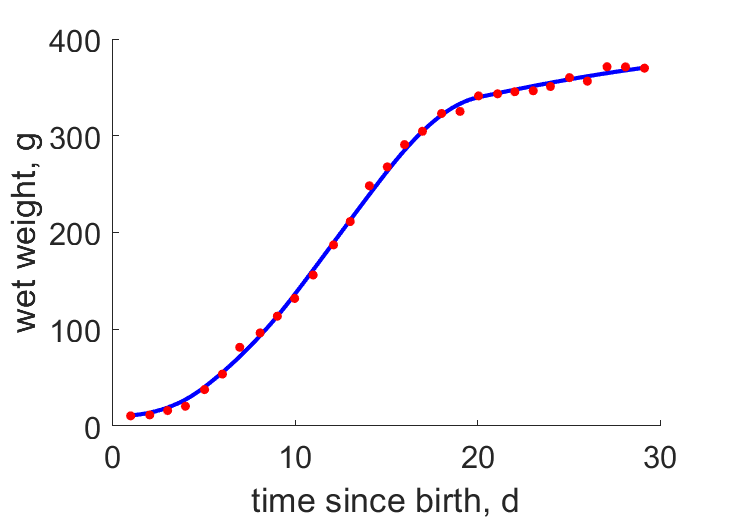Predictions & Data for this entry
| Model: std | climate: BSk, Cfa, Dfa | migrate: | phylum: |
| COMPLETE = 2.5 | ecozone: THn | food: bxCi, xiO | class: |
| MRE = 0.006 | habitat: 0iTf, 0iTi | gender: Dg | order: |
| SMSE = 0.000 | embryo: Tnpfm | reprod: O | family: |
Zero-variate data
| Data | Observed | Predicted | (RE) | Unit | Description | Reference |
|---|---|---|---|---|---|---|
| ab | 18 | 18.22 | (0.01237) | d | age at birth | AnAge |
| tx | 29 | 28.97 | (0.00109) | d | time since birth at fledging | WhitMarz1998 |
| tp | 87 | 86.68 | (0.003695) | d | time since birth at puberty | guess |
| tR | 730 | 730 | ( 0) | d | time since birth at 1st brood | AnAge |
| am | 7300 | 7313 | (0.001789) | d | life span | AnAge |
| Wwb | 10.3 | 10.23 | (0.006384) | g | wet weight at birth | WhitMarz1998 |
| Wwi | 384.8 | 387 | (0.005655) | g | ultimate wet weight | AnAge |
| Ri | 0.0137 | 0.01368 | (0.001714) | #/d | maximum reprod rate | AnAge |
Uni- and bivariate data
| Data | Figure | Independent variable | Dependent variable | (RE) | Reference |
|---|---|---|---|---|---|
| tW |  | time since birth | wet weight | (0.01589) | WhitMarz1998 |
Pseudo-data at Tref = 20°C
| Data | Generalised animal | Corvus brachyrhynchos | Unit | Description |
|---|---|---|---|---|
| v | 0.02 | 0.03602 | cm/d | energy conductance |
| p_M | 18 | 668.7 | J/d.cm^3 | vol-spec som maint |
| k_J | 0.002 | 0.02732 | 1/d | maturity maint rate coefficient |
| k | 0.3 | 0.2992 | - | maintenance ratio |
| kap | 0.8 | 0.9718 | - | allocation fraction to soma |
| kap_G | 0.8 | 0.7999 | - | growth efficiency |
| kap_R | 0.95 | 0.95 | - | reproduction efficiency |
Discussion
- Scaled functional response varies in time
- mod_1: v is reduced
- mod_2: Pseudo-data point k is used, rather than k_J; Data set tp and parameter t_R are added, the latter replacing clutch interval t_N. Postnatal T is based on PrinPres1991, see get_T_Aves. See further the revision page, theme puberty
Bibliography